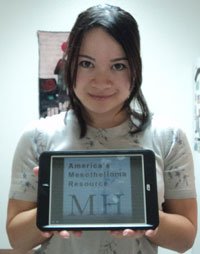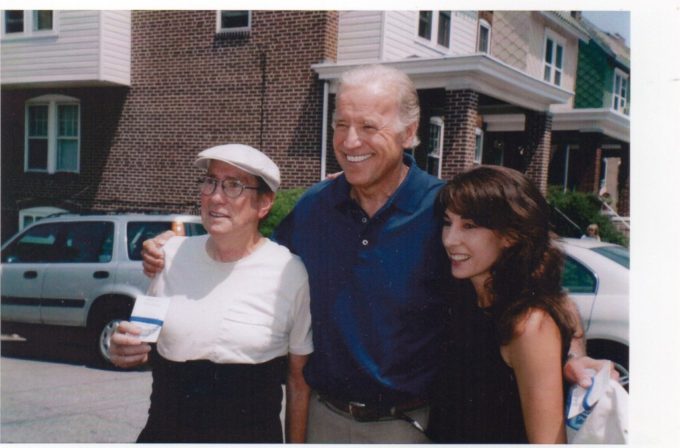Author: Nancy Meredith

Essay Contest: Win an Apple iPad Mini
Contestants in the MesotheliomaHelp Scholarship Essay Contest sponsored by Belluck & Fox, LLP, have an additional chance to win a iPad-mini.
Share the essay contest with friends and family on Twitter and Facebook for a chance to win an Apple iPad Mini. The more you tweet the more opportunities you have. Please remember that to be eligible to win you should submit your essay in the annual essay scholarship contest. One lucky ipad-mini winner will be selected at random!
Every year, as an incentive to get people participating in our scholarship contest, we provide a chance for students to win an iPad Mini by sharing their essays with friends, family and all readers of MesotheliomaHelp.
 Maryam Khazraee:
Maryam Khazraee:
Maryam Khazraee is a Third Year Doctorate of Pharmacy student at the University of Florida. If she could only choose three words to describe herself they would be Leader, Activator, and Achiever. She has consistently shown determination and perseverance for knowledge, compassion in helping others, and justice in creating fairness among all. Her interests include managed care pharmacy, oncology, and specialty drug development. She could like to pursue further education by completing an oncology residency or pharmaceutical industry fellowship while utilizing her skills and experiences in making a positive global impact.
 Kim Forgione:
Kim Forgione:
Kim Forgione graduated from the University of Montana with a degree in wildlife biology. She is now looking forward to starting a doctorate of optometry program next fall at Pacific University College of Optometry.

The History of Asbestos Use in America
One day my grandfather felt really sick and so my grandmother went with him to the emergency room. My family had no idea what was wrong, but we didn’t think it was anything serious. He stayed in the hospital for a few days and soon after, he had numerous blood tests and a lung biopsy procedure which eventually showed that he had been living with mesothelioma. He got much sicker all of a sudden and we knew that he wouldn’t be with us much longer because of his late stage mesothelioma diagnosis. This hit our family very hard. My grandfather was a construction worker in New York City for many years until he retired. He bravely worked on some of the tallest skyscrapers.
He would always tell stories about his life on the job; walking across tiny beams hundreds of feet in the air with no harnesses, eating lunch on the beams with an amazing view of the city, or playing pranks on his workmates. He loved his job. Unfortunately, through working on these buildings, he was unknowingly exposed to asbestos. His job, which he took so much pride in, is what caused his premature death. He passed away one year ago in February, just thirty days after his mesothelioma diagnosis. I wasn’t ready to say goodbye to him. It is not fair that the companies producing the asbestos products that my grandfather was exposed to knew of their potential dangers, yet he was kept in the dark.
Asbestos was discovered by the Ancient Greeks more than two thousand years ago. The Greeks noted its harmful biological effects. They noted the “sickness of the lungs” in the slaves that worked with asbestos, but its seemingly magical properties overruled the obvious symptoms. The use of asbestos declines during the Middle Ages, but reappeared in the 1700s and became popular along with the Industrial Revolution during the late 1800s. This is when it began being used as insulation for steam pipes, turbines, boilers, kilns, ovens, and other high-temperature products.
Asbestos insulation was the biggest source of asbestos exposure for workers throughout the 1900s. Heat insulation containing asbestos was used for the first time in 1866. In 1870 asbestos was mixed with cement for boiler covering. By 1874, asbestos insulation products reached commercial production and were sold on a mass scale. Bans on asbestos-containing insulation didn’t appear until the 1970s. One of the primary manufacturers of asbestos insulation products was Johns Manville.
In the 1930s major medical journals began to publish articles which linked asbestos to cancer. People may be exposed to asbestos in their workplaces, communities, or even homes. Asbestos products release tiny asbestos fibers into the air. When these fibers are breathed in, they may get trapped in the lungs. The fibers accumulate in the lungs over time and eventually lead to mesothelioma. Many of the people currently fighting mesothelioma in America were unwittingly exposed to asbestos in their younger years and were shocked to find out that they had been exposed to such a harmful substance for such a long period of time.
After it was publically established that asbestos was linked to cancer, most asbestos products were banned in the United States. The United States Environmental Protection Agency (EPA) finally began banning some asbestos related products in the 1970s. In 1990, the EPA overturned the bans and instead prohibited spray-on application of materials containing more than 1% asbestos to buildings, structures, pipes, and conduits. Asbestos is still legally allowed in certain small concentrations but these concentrations can still be harmful with on-going exposure. Asbestos exposure is still an issue in America today.
Asbestos is present in new products and materials and an estimated thirty million schools, homes, and workplaces are still contaminated with asbestos. Most asbestos used in the United States today is imported. Asbestos is still used commercially in brake pads, automobile clutches, roofing materials, vinyl tile, and imported cement pipe and corrugated sheeting. This is significantly fewer products than had previously contained asbestos, but I still feel that these uses are unnecessary. Steps need to be taken in order to not only stop the production of products containing asbestos, but to remove the existing asbestos from old buildings and products.
My grandfather worked on the first skyscrapers that utilized spray-on asbestos insulation in New York City. Construction workers were surrounded by asbestos every day, yet they were all unaware of the harmful effects that would hit them later in life. Proper precautions were not taken many years ago and the results to that generation of workers are horrific. Sadly, there is no happy ending to the History of Asbestos Use in America.

My Hero
by Samantha Robeson
A yellow Post-It note is stuck over his mouth with a drawing of a huge smile on it; a furry stuffed hedgehog sits precariously on top of his head. Memories of my Poppop always bring a smile to my face. The side effects from the medication of the latest clinical trial didn’t make Poppop’s hair fall out, but it made it curly and wiry. He called himself Brillo Head and would make his grandkids giggle by using our stuffed animals as his wigs. Poppop always had a smile on his face; if the pain was too bad or if he was too weak to smile, he would draw one on his face so that we knew he was still happy inside. He wasn’t just a survivor; he was so much more to all of those who had the pleasure of being in his presence. Nobody knows how he could stay so positive for so long in the face of such pain and suffering. When he was hurting so badly that he couldn’t hide the anguish, he would hide from his loved ones so as not to upset them. It sounds cliché to say that my Poppop was such an inspiration, but it is hard to put into words how his charisma and optimism touched those around him. He was my hero.
 For 38 years, Carl Roca “Poppop” was a pipefitter; like millions of other tradespeople, service men and shipyard workers, he was being exposed to asbestos on a daily basis. It wasn’t until 1986 that he got a letter from his union talking about the dangers of asbestos, and recommending that he get a screening. It showed a little scarring on his lungs but nothing to be concerned about; the follow-up appointment with the pulmonologist confirmed that his condition was stable. In 2001 Poppop started to have chest pains and shortness of breath. He went back to the pulmonologist, who still didn’t suspect mesothelioma; he performed surgery to drain the fluid and he took the liberty to scrape the scar tissue. After the surgery, he told the family that he knows what cancer looks like, he was sure Poppop didn’t have cancer and that he should be fine. Sadly, while being discharged from the hospital, Poppop saw the word “mesothelioma” scrawled on a piece of paper. It was up to the family to learn about this dreadful disease.
For 38 years, Carl Roca “Poppop” was a pipefitter; like millions of other tradespeople, service men and shipyard workers, he was being exposed to asbestos on a daily basis. It wasn’t until 1986 that he got a letter from his union talking about the dangers of asbestos, and recommending that he get a screening. It showed a little scarring on his lungs but nothing to be concerned about; the follow-up appointment with the pulmonologist confirmed that his condition was stable. In 2001 Poppop started to have chest pains and shortness of breath. He went back to the pulmonologist, who still didn’t suspect mesothelioma; he performed surgery to drain the fluid and he took the liberty to scrape the scar tissue. After the surgery, he told the family that he knows what cancer looks like, he was sure Poppop didn’t have cancer and that he should be fine. Sadly, while being discharged from the hospital, Poppop saw the word “mesothelioma” scrawled on a piece of paper. It was up to the family to learn about this dreadful disease.
The oncologist explained that the procedure done by the pulmonologist (partial decortication) severely limited Poppop’s later treatment options such as a pleurectomy or pneumonectomy. Also, one of Poppop’s ribs was broken during the surgery; the severe pain was from the nerve bundle that was then trapped. Surgery to fix the rib was not recommended due to the spreading cancer. The oncologist told Poppop that he had 6 months to live, and since chemotherapy would not cure the cancer he wouldn’t recommend any treatments. He suggested that Poppop get his affairs in order. If this were me, I would be ticked off at the asbestos companies and the pulmonologist who told me I didn’t have cancer. Not Poppop—he never worried about himself, because he was too busy caring about Mommom, his four kids and us 10 grandchildren. He wasn’t going to let this death sentence kill his spirit.
Poppop was only 60 years old; how could he have only 6 months left to live? We spent every weekend with him in the summer, when the family would crowd into his little trailor at the beach to enjoy each other’s company. He was just chasing me around with a live crab saying it was going to bite my nose. Poppop was the one who took care of everything for everybody; he fixed everyone’s toilets, heaters, cars, boats and he even knew how to fix broken hearts with a smile. Poppop would make sure everyone else’s problems were fixed before he tended to his own leaky faucet. What would we do without our Poppop? Everything would fall apart and no one would laugh ever again!
Have no fear, Poppop is here to put a smile back on everyone’s face. He wasn’t going to let a little cancer destroy his family. He would joke with all of saying “Meeezofeeeleeeheeemeeesheemeeomia– how could something with such a goofy name be so scary?” Comic relief was our saving grace when Poppop was around. My mom tried not to let us kids see her cry, but I remember how she didn’t go to sleep for days because she was doing research to find some ray of hope. Finally, she found a story about a man with mesothelioma who was involved in a clinical trial and was beating the odds. Within days, Poppop was on the phone with this survivor, and my mother had used a ream of paper printing out information about the clinical trials for people with mesothelioma.
Poppop’s 6 month death sentence turned into a 6 year stay. He looked at each day as a gift, and he taught us to be grateful rather than resentful. While participating in the various clinical trials, Poppop spoke to newly diagnosed patients who had no idea what they should do next. Naturally, he found a way to make even the sickest people smile. Mommom would tell us stories about Poppop’s antics when he was getting his treatments with the other cancer patients; his silly jokes would make not only the other patients but also the medical staff crack up. In addition to being a great support to other cancer patients and their families, he also educated others by talking to various community, medical and labor groups. In 2005, the Graham Cancer Center (Delaware) awarded my Poppop with the “Community Excellence Service Award” for reaching out to help others.
My Poppop also helped to raise awareness about Mesothelioma at the federal level, but that was no easy task. He never gave up; he wrote letters until the officials agreed to meet with him, he took multiple trips to Washington D.C., and he would track down our state officials at every carnival and parade they attended. Senator Joseph Biden (who is now our Vice President), replied to every letter, met with my father and wore the blue Mesothelioma Awareness bracelet my father and mother gave him. When I look at the picture of my Poppop talking with Representative Michael Castle about mesothelioma, it is hard for me to believe that less than 4 months later he took his last breath. My Poppop had to wear a tight band wrapped around him and suck on pain lozenges, but this didn’t stop him from spreading awareness. (see the attached photos)
A month after my Poppop was laid to rest, my Mommom was mailing information to the government officials with a cover letter stating, “My husband died from mesothelioma…He was in the process of writing the attached letter when his cancer became very aggressive, so he was never able to mail it. Since he was diagnosed with mesothelioma six years ago, his main concern has been to inform the public…Before he died I promised him that the letter would be mailed. Please take a few minutes to read it.” Years after his passing, we continue to spread awareness in his memory; along with my mother, brother and Mommom, I went to Washington D.C. and was able to share our family story with those on Capitol Hill. I wish my Poppop could have been at my high school graduation and could see how hard I am working in college, but instead of being sad, I feel joy that he was an important part of my life. Hopefully one day, I’ll become a Bio-Medical Engineer who helps to develop treatment options that enable those with cancer to write their own personal survival story.
About
 Samantha Robeson is a Sophomore studying engineering at the University of Delaware. My goal is to get into the Bio-Medical Engineering Program so that I can help in the search for a cure and the development of better treatment for those with cancer. My grandfather’s brave fight against mesothelioma has inspired me to enter the field of cancer research, and I hope to make a difference.
Samantha Robeson is a Sophomore studying engineering at the University of Delaware. My goal is to get into the Bio-Medical Engineering Program so that I can help in the search for a cure and the development of better treatment for those with cancer. My grandfather’s brave fight against mesothelioma has inspired me to enter the field of cancer research, and I hope to make a difference.

Haider F. Zahabi
By: Haider F. Zahabi
As a child growing up in Iraq, I lived through the end of the Iran and Iraq war as well as the American and Iraq war. I can remember seeing buildings and cars blown up on a daily basis. I can remember the dust and debris from these buildings that filled the air. I remember the thick smoke from burning oil refineries that made breathing nearly impossible. As I grew I began to see more and more people getting sick. I saw many older men and women coughing and having trouble breathing even when the air seemed clear. I observed people walking around in pain and suffering. I figured they were getting old. As an adult, I discovered that these people were not just getting old but in fact were very sick. These people were among the thousands of people who are sick from mesothelioma and other cancers caused by such materials as asbestos.
During geology class I learned that asbestos is a naturally occurring substance that is processed into a fire resistant fibrous structure with great thermal insulation properties and high tensile strength that many manufacturers and home builders liked to use. Many builders used asbestos in floor tiles, insulation, shingles, cement and many other items used in home construction in Iraq. It was the asbestos in the building materials that were making many of the Iraqis I saw sick. When the buildings and structures they lived in or around were destroyed from bombings, the deadly asbestos became airborne. The people would walk around inhaling the deadly asbestos fibers. Many of these people were unaware that something as simple as breathing would kill them later. As people aged the fibers that embedded themselves in the lungs of these innocent people began to make them sick. The worst part is it was not just older people that were getting sick; it was middle age adults like my best friend’s uncle who was only 40 years old. What I realized was many people died and are getting sick because builders and manufacturers did not and will not stop using such materials such as asbestos despite knowing the dangers. This knowledge pushed me to go to school to get an education in which I could make a difference. I knew I could not be a doctor or a scientist but I knew I could be an engineer and work to make safe options for people.
While I cannot change the past, I can continue my education, help educate the future and raise awareness of the deadly effects of asbestos and other carcinogens. I want to educate Americans and other countries that have lax building codes and manufacturing regulations. People all over the world deserve to be educated and made aware of the dangers. They need to understand how to protect themselves. Furthermore, by becoming an engineer, I can ensure that the company I work for considers the effects these chemicals and materials have on people. I want to be able to look at the people who utilize my products or inhabit the buildings I help build. I do not ever want to know that I cut corners and saved money at the risk of someone’s health. Finally I want to be able to tell people who are suffering and their families that I will work hard to ensure that future generations will not have to experience what they have. I want them to know that I will fight for them.
Overall mesothelioma is a preventable disease that my country men and others should never have to experience. This disease can be eradicated through education and the institution of laws to protect the innocent. I do not want people to be afraid of the materials in their house. Additionally I want to see restrictions implemented in America, Iraq and other countries that have failed to protect their people. Furthermore I want people to understand how devastating a disease like mesothelioma is to families. The public needs to understand that watching a family member suffer through a preventable disease is not only heartbreaking but devastating.
To all people who are suffering or is a family member of someone who is suffering I would say, keep your head up. I cannot say that I personally know what you are going through but know there are people out there who care and will fight for you and your rights. I, along with many others, will work to improve laws that can help prevent this from happening again. Finally I would say you are in my prayers and will be there for you.
About
 Haider F. Zahabi
Haider F. Zahabi
My name is Haider Zahabi and I am from Baghdad, Iraq. I moved to the United States in 2012 and currently live in Houston, Texas. I have been working to get my Bachelor’s Degree in Mechanical Engineering since 2013. In Iraq I worked with the U.S. military as an Interpreter in order to help build a positive relationship between Iraqis and Americans. I plan on getting my degree and making a positive impact in the world!!

My grandfather, Jim Shiffer
by Justin Hellier
Full bodied screams filled the hospital hallways. My grandfather, Jim Shiffer, was dead. Mesothelioma had ravaged his body for over two years, and the battle that had left the heart in my family torn was finally over.
Jim Shiffer was a strapping man who could lift more than most 20-somethings at the age of 70. He was an accomplished painter with dozens of paintings of famous vacation spots around the world hung up on his walls, all of which he had seen and experienced with his own eyes. His most notable accomplishment was rising to become the president of Pacific Gas and Electric Company where he oversaw thousands of engineers. After a lifetime of hard work, he was able to retire, which gave him more time to focus on what was always a priority to him: family. He planned all of the family gatherings and brought everyone closer to each other. He is the only reason I was able to spend so much time with all of my aunts and uncles during the holidays making memories that will last forever. His passion for golfing was taken to the next level, making 2nd place a solid standing for anyone who played a round of golf with him. My grandmother talked about Jim constantly and loved everything about him, from the nonstop traveling to the intimate conversations they would have. Jim was a caring man that everyone looked up to, but every great thing must come to an end.
On Thanksgiving of 2011, my grandfather was taken to the hospital due to his erratic coughing. The doctors found 2 liters of cloudy fluid in his lungs and drained it out that night. He had to wait three days for the doctor diagnosis. They told him that he had a terminal cancer called mesothelioma. Asbestos is the only thing known to cause this type of cancer and it didn’t take long to realize where he had been exposed to it. The very thing he spent his whole life climbing to achieve was the very thing that ended his life. During his time working at power plants in the 70’s and 80’s, he worked in asbestos-filled areas. PG&E was using asbestos as insulation and twenty years of breathing it lead to the formation of cancer cells. The doctor only gave him three to six months to live. Jim’s father lived to be 98 years old and in that very moment, 20 years of plans to travel, golf, and spend time with the people he loved, was reduced to enough time to plan a funeral.
With little time left, Jim spent most of it making sure his family was taken care of and that my grandma was able to support herself. With his spare time, he managed to keep up most of his hobbies and lived as if cancer wasn’t spreading through his body. But time passed and he began to feel the effects. Chemotherapy only seemed to harm his body even more and with every treatment came days of nausea and pain. Even though he wasn’t given long to live, he manage to fight his way to live for two year longer then the doctors said. As the cancer grew, Jim grew weaker. His days playing golf were replaced with lying on the couch and his clubs were replaced with an oxygen tank. In the end, everything he loved to do was stripped from him and the inevitable happened. On March 20, 2014, as Jim Shiffer passed away, my grandmother realized that no matter how long you prepare, nothing can compare to the reality. Her cries were heard through the whole hospital and the doctors calmed her down with drugs. That was the end.
A settlement was made for people like Jim that were exposed to asbestos in the work area due to the careless actions of contractors and subcontractors. A portion of the settlement has been given to my grandma, and she is able to live well and has paid off all of the medical bills. Even after his death, Grandpa Jim still had one last lesson to teach me: No matter how much money we got from the settlement, he was never going to come back. Mesothelioma is serious and no one should have to go through what my family and numerous families around the world have had to go through. This cancer can be stopped and people everywhere are making sure that it does get stopped. I respect every person that makes choices to get rid of asbestos and I know that one day no one will have to suffer from mesothelioma needlessly.
About
 Justin Hellier attends Irvine Valley College and plans to transfer to a 4-year university in 2015. Justin was able to relate very closely to the contest and the essay as his grandfather battled Mesothelioma for over two years. Justin’s message to families fighting mesothelioma is that “this is when family matters the most.”
Justin Hellier attends Irvine Valley College and plans to transfer to a 4-year university in 2015. Justin was able to relate very closely to the contest and the essay as his grandfather battled Mesothelioma for over two years. Justin’s message to families fighting mesothelioma is that “this is when family matters the most.”
Free Mesothelioma Patient & Treatment Guide
We’d like to offer you our in-depth guide, “A Patient’s Guide to Mesothelioma,” absolutely free of charge.
It contains a wealth of information and resources to help you better understand the condition, choose (and afford) appropriate treatment, and exercise your legal right to compensation.
Download Now